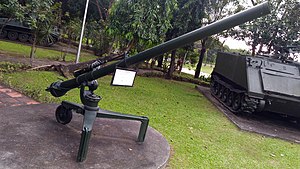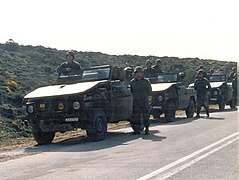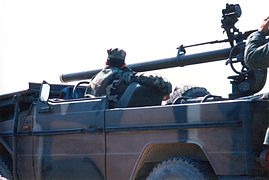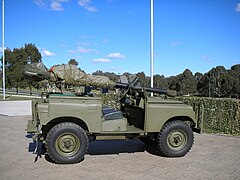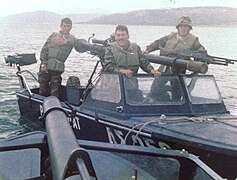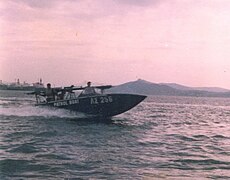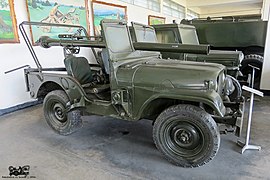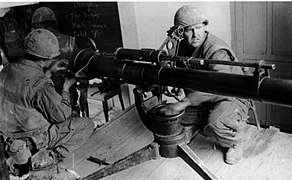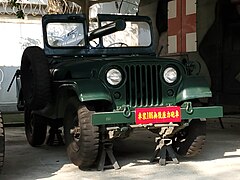M40 recoilless rifle
The M40 recoilless rifle[17][18][19][20] is a portable, crew-served 105 mm recoilless rifle made in the United States. Intended primarily as an anti-tank weapon, it could also be employed in an antipersonnel role with the use of an antipersonnel-tracer flechette round. The bore was commonly described as being 106 mm caliber but is in fact 105 mm; the 106 mm designation was intended to prevent confusion with incompatible 105 mm ammunition from the failed M27.[17] The air-cooled, breech-loaded, single-shot rifle fired fixed ammunition and was used primarily from a wheeled ground mount or M92 ground mount.[20] It was designed for direct firing only, and sighting equipment for this purpose was furnished with each weapon, including an affixed M8C .50 cal spotting rifle.

297 M50 "Ontos" were built as self-propelled light armored tracked anti-tank vehicles.[21] They had six 105 mm M40 recoilless rifles as their main armament, which could be fired in rapid succession against a single target to guarantee a kill. The M40 could also be used on the M274 4×4 utility platform "mechanical mule."[20]
Replacing the M27 recoilless rifle, the M40 primarily saw action during the Vietnam War and was widely used during various conflicts thereafter in Africa or in the Middle East. It was replaced by the BGM-71 TOW anti-tank missile system in the US Armed Forces.
Design history
[edit]The earlier M27 recoilless rifle was a 105 mm weapon developed in the early 1950s and fielded in the Korean War. Although a recoilless rifle of this caliber had been a concept since the Second World War, the weapon was hurriedly produced with the onset of the Korean War. The speed with which it was developed and fielded resulted in problems with reliability caused by trunnions that were mounted too far to the rear. The M27 was also considered too heavy by the U.S. Army and had a disappointing effective range due to the lack of a spotting rifle. Taking the M27 as the basis for a new design, the Army developed an improved version of the M27 that was type-designated the M40 106-mm recoilless rifle in 1955.[22] Although unsuitable for military purposes, M27 recoilless rifles were used to trigger controlled avalanches at ski resorts and mountain passes in the United States.[23]
Description
[edit]The M40 is shaped like a long tube with an M8C .50 cal spotting rifle above. The spotting rifle fires a round whose trajectory closely matches that of the 105 mm round and gives off a puff of smoke on impact with the target. On the left side, there is an elevating wheel, in the center of which is the trigger wheel used to fine adjust the elevation and at the same time firing the spotting rifle when pulled, and the gun when pushed. The mounting is a tripod, but the front leg has a castering wheel. On top of the mount is a traverse wheel. On the center of the traverse wheel is a locking wheel, when the wheel is down, the rifle is locked in traverse, and can only be moved right and left with the traverse wheel. When the wheel is raised, the rifle can be traversed by hand. Austria produced a two-wheeled mount for the M40.
The whole mounting can be placed on an M151 Jeep for mobile use.[24] It has also been mounted on M113s, UMM 4x4s,[24] Jongas,[25] Fath Safirs,[26] Land Rover Defenders,[27] Mercedes-Benz G-Wagen,[28] Hotchkiss M201 jeeps,[1] Toyota Land Cruisers,[8] Jeep CJs, Willys M38s, HMMWVs, M274 Mechanical Mules, Tiuna 106 mm weapons platforms, JODDB (formerly King Abdullah II Design and Development Bureau) Al Jawad vehicles, RBY MK 1s, AIL Abirs and AIL Storms.[7] They were also used on US Navy minesweepers (MSO) during Operation Market Time in Vietnam.
A special vehicle called the Ontos carried six M40s. A version specific to the T195E5 mount, the M40A1C, was used. It was used only by the U.S. Marine Corps. Some Pakistani M113s have a dual mounting.[citation needed] Three Panagopoulos coastal patrol boats class of the Hellenic Coast Guard and the Hellenic Navy in service of 1976-2003 was armed with two sextuples M40.[citation needed]
The M40 was a very successful export item and continues to be used by South Korea, Ecuador, Estonia, Greece, Honduras, Iran, Lebanon, Malaysia, Mexico, Morocco, the Philippines, Taiwan, Turkey, Colombia, Venezuela and many others, as well as anti-government forces in the Libyan Civil War and Syrian civil war.[11]
Non-US production
[edit]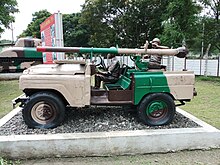
| Country | Producer | Local name | Remarks |
|---|---|---|---|
| Austria | Lohner GmbH | 10.6 cm rPAK M40A1 | Locally produced carriage[29] |
| China | Norinco | Type 75[30] | Towed and SP versions[24] |
| India | Ordnance Factory Board | Mounted on tripods or on Jongas[25] | |
| Iran | Defense Industries Organization | [24][31] | |
| Japan | Japan Steel Works | Type 60 | |
| Pakistan | Pakistan Machine Tool Factory Limited | [32] | |
| South Korea | Kia Machine Tool Company | KM40A2 | [24] |
| Spain | Santa Bárbara Sistemas[33] | CSR-106[34] |
Ammunition
[edit]Ammunition for the 105 mm rifle was issued as one-piece fixed cartridges. The term "fixed" means that the projectile and the cartridge case are crimped together. This ensures correct alignment of the projectile and the cartridge case. It also permits faster loading because the projectile and the cartridge case are loaded as one unit.[35] The rear end of the cartridge case is perforated, to allow the propellant gas to escape through the vented breech, thus neutralizing recoil.[36] Most projectiles (except HEAT) used are pre-engraved, that is, the rotating bands are cut to engage the rifled bore.[37]
Types of ammunition included HEAT, High Explosive Plastic-Tracer (HEP-T), canister, High Explosive Anti Personnel, and the M368 dummy round which could not be fired and was used for crew drill. The original U.S. HEAT round penetrated more than 400 mm of armor. Near the end of the M40's service life, both Austria and Sweden produced HEAT rounds for the weapon capable of penetrating more than 700 mm of armor.[38]
| Producer | Round name |
Type | Proj Weight |
Proj Filler |
Filler weight |
Armor penetration |
Effective range |
|---|---|---|---|---|---|---|---|
| United States | M494 | APERS-T | N/A | N/A | N/A | N/A | 300 m |
| United States | M581 | APERS | 9.89 kg | flechettes | 4.94 kg | N/A | 300 m |
| Spain | M-DN11 | HEAP | 3.6 kg | Hexogen | 0.77 kg | N/A | 1500 m |
| West Germany | Diehl 106 mm | Fragmentation | 8 kg | steel balls | 3.5 kg | N/A | N/A[39] |
| France | NR 160 | HEAT-T | N/A | N/A | N/A | N/A | N/A |
| France | NR 483 | APERS | N/A | flechettes | N/A | N/A | N/A |
| France | NR 601 | HESH-T | 7.8 kg | Comp. A3 | N/A | N/A | N/A |
| Italy | PFF | HE | 9.89 kg | Comp. B | N/A | N/A | N/A |
| United States | M346A1 | HEP-T | 7.96 kg | Comp. A3 | 3.5 kg | N/A[40] | N/A |
| United States | M344A1 | HEAT | 7.96 kg | Comp. B | 1.27 kg | over 400 mm[41] | 1350 m |
| Pakistan | M344A1 type round | HEAT | 6 kg | N/A | N/A | 500 mm | 2012 m[32] |
| India | ? | HEAT | 16.78 kg (round) | N/A | N/A | 600 mm | 1372 m[25] |
| Sweden | 106 3A | HEAT-T | 5.5 kg | Octol | 1.0 kg | over 700 mm[42] | 2000 m |
| Austria | RAT 700 | HEAT | 5.0 kg | N/A | 1.1 kg | over 700 mm | N/A[43] |
| Austria | 3.1 RAT 700 | HEAT-T | 5.7 kg | Octastit | 1.1 kg | over 700 mm | N/A[44] |
Spotting rifle
[edit]The ammunition for the M8C spotting rifle is not .50 BMG, but a 22mm shorter (12.7x77mm) round than used in .50 caliber machine guns. The spotter round was developed to replicate the trajectory of the 106 mm ammunition, and features a tracer element and a point-detonating incendiary filler to create a puff of white smoke at the impact point. Four of the six 106mm rifles on the M50 Ontos mounted spotter rifles. Spotter rounds had a yellow tip with a red band and practice cartridges had a green tip.
Although the spotting rifle could conceivably be used in an antipersonnel role, historic U.S. military doctrine strongly discouraged this use, for a purely tactical reason—to conceal the vulnerable M40 and its crew from the enemy until the main rifle was ready to fire. However, this restriction is believed to be the source of a long-standing misconception that the laws of war restrict the use of .50-caliber projectiles against enemy personnel more generally.[45]
Civilian use
[edit]In the early 1990s, the United States Forest Service (USFS) introduced the M40 for avalanche control as ammunition stocks for its M27 rifles became depleted. The M40 was initially successful due to operational similarities to the familiar M27 and ready availability from the U.S. military; however, in 1995, a USFS gunner was killed by shrapnel after a low-level premature warhead detonation inside an M40 barrel. The accident was attributed to an undiscovered hairline crack in the projectile's base plate. Following this incident, most USFS M40s were quickly replaced with surplus 105 mm howitzers, but a few were kept in service with safety barriers to protect the gunners, who fired the guns remotely. In December 2002, two M40s at Mammoth Mountain were destroyed by catastrophic bore explosions 13 days apart. The gunners were uninjured, having been protected by the safety barriers, but the incidents prompted the USFS to retire all remaining M40s in July 2003.[46]
Also in the mid-1990s, Parks Canada acquired four M40s for avalanche control to replace the Canadian Armed Forces using 105 mm towed howitzers in Rogers Pass (British Columbia) on the Trans-Canada Highway. Special pedestals were built at specific locations and a pneumatic remote firing system was devised to allow the operators to fire the recoilless rifle safely in case of ammunition malfunction. After a trial period, the M40s plan was abandoned and the Canadian Armed Forces once again began providing 105 mm towed howitzers and artillery personnel to conduct avalanche control.[citation needed]
Users
[edit] Angola: used by mercenaries of FNLA on Land Rovers[27] and by UNITA.[4]
Angola: used by mercenaries of FNLA on Land Rovers[27] and by UNITA.[4] Australia: replaced the 6-pdr gun from 1961. Remained in service into the 1990s[47] and in limited use in Afghanistan.[11]
Australia: replaced the 6-pdr gun from 1961. Remained in service into the 1990s[47] and in limited use in Afghanistan.[11] Austria: Locally produced as 10.6 cm rPAK M40A1[29]
Austria: Locally produced as 10.6 cm rPAK M40A1[29] Bahrain: 25 M40A1s as of 2016[update][48]
Bahrain: 25 M40A1s as of 2016[update][48] Bangladesh: 238 M40A1s as of 2016[update][49]
Bangladesh: 238 M40A1s as of 2016[update][49] Bolivia[50]
Bolivia[50] Brazil: 194 M40A1s as of 2016[update][51]
Brazil: 194 M40A1s as of 2016[update][51] Burkina Faso[52]
Burkina Faso[52] Cambodia[53]
Cambodia[53] Cameroon: 40 M40A2s as of 2021[update][54]
Cameroon: 40 M40A2s as of 2021[update][54] Canada[55][56]
Canada[55][56] Central African Republic: 14 as of 2016[update][57]
Central African Republic: 14 as of 2016[update][57] Chad[8][58]
Chad[8][58] Chile: 213 M40A1s as of 2016[update][59]
Chile: 213 M40A1s as of 2016[update][59] China: Locally produced as Type 75[30]
China: Locally produced as Type 75[30] Colombia: 73 M40A1s as of 2016[update][60]
Colombia: 73 M40A1s as of 2016[update][60] Comoros[citation needed]
Comoros[citation needed] DR Congo[61]
DR Congo[61] Cyprus: 144 M40A1s as of 2016[update][62]
Cyprus: 144 M40A1s as of 2016[update][62] Denmark:[55][63] remained in limited service in Afghanistan.[11]
Denmark:[55][63] remained in limited service in Afghanistan.[11] Djibouti: 16 M40A1s as of 2021[update][64]
Djibouti: 16 M40A1s as of 2021[update][64] Dominican Republic: 20 M40A1s as of 2016[update][65]
Dominican Republic: 20 M40A1s as of 2016[update][65] Ecuador: 24 M40A1s as of 2016[update][66]
Ecuador: 24 M40A1s as of 2016[update][66] Egypt
Egypt El Salvador: 20 M40A1s as of 2016[update],[67] including some Spanish-made guns[33]
El Salvador: 20 M40A1s as of 2016[update],[67] including some Spanish-made guns[33] Estonia:[68] 30 M40A1s as of 2016[update][69]
Estonia:[68] 30 M40A1s as of 2016[update][69] France[1]
France[1] Gabon[70]
Gabon[70] Guatemala: 56 M40A1s as of 2016[update],[71] including some Spanish-made guns[33]
Guatemala: 56 M40A1s as of 2016[update],[71] including some Spanish-made guns[33] Greece: 581 M40A1s as of 2016[update][72]
Greece: 581 M40A1s as of 2016[update][72] Haiti[73]
Haiti[73] Honduras: 50 M40A1s as of 2016[update],[74] including some Spanish-made guns[33]
Honduras: 50 M40A1s as of 2016[update],[74] including some Spanish-made guns[33] India: M40A1C locally produced.[25] More than 3,000 in service as of 2016[update][75]
India: M40A1C locally produced.[25] More than 3,000 in service as of 2016[update][75] Indonesia[76]
Indonesia[76] Iran: Locally produced.[77] ~200 M40s in service[78]
Iran: Locally produced.[77] ~200 M40s in service[78] Iraq
Iraq
 Islamic State[80]
Islamic State[80] Israel[3][81]
Israel[3][81] Italy[55][82]
Italy[55][82] Ivory Coast: ~12 M40A1s as of 2016[update][83]
Ivory Coast: ~12 M40A1s as of 2016[update][83] Japan:[84] Locally produced by Japan Steel Works as Type 60
Japan:[84] Locally produced by Japan Steel Works as Type 60 Jordan[85]
Jordan[85] Laos[86]
Laos[86] Lebanon: 113 M40A1s as of 2016[update][87]
Lebanon: 113 M40A1s as of 2016[update][87]
 Lesotho: 6 M40s as of 2021[update][88]
Lesotho: 6 M40s as of 2021[update][88] Liberia[89]
Liberia[89] Libya: American, Chinese and Iranian variants[12]
Libya: American, Chinese and Iranian variants[12] Luxembourg[55][90]
Luxembourg[55][90] Madagascar[91]
Madagascar[91] Malaysia: 24 M40s as of 2016[update][92]
Malaysia: 24 M40s as of 2016[update][92] Mauritania: ~90 M40A1s as of 2016[update][93]
Mauritania: ~90 M40A1s as of 2016[update][93] Mexico[94] - including some Spanish-made guns[33]
Mexico[94] - including some Spanish-made guns[33] Morocco: 350 M40A1s as of 2016[update][95]
Morocco: 350 M40A1s as of 2016[update][95] Myanmar: more than 1,000 M40A1 RCLs in service as of 2016[update],[96] including Spain made CSR-106s and Pakistani-made M40A1s.[32] used for bunker busting and anti-personnel/infantry support role in counter-insurgency campaigns.
Myanmar: more than 1,000 M40A1 RCLs in service as of 2016[update],[96] including Spain made CSR-106s and Pakistani-made M40A1s.[32] used for bunker busting and anti-personnel/infantry support role in counter-insurgency campaigns. Netherlands[55]
Netherlands[55] New Zealand[97]
New Zealand[97] Nicaragua
Nicaragua Niger: 8 M40s as of 2016[update][98]
Niger: 8 M40s as of 2016[update][98] Nigeria[99]
Nigeria[99] Norway[55][100] - Identified as 106mm Rekylfri Kanon M40[7]
Norway[55][100] - Identified as 106mm Rekylfri Kanon M40[7] Pakistan: Locally produced.[32] Still in service as of 2020[update][101]
Pakistan: Locally produced.[32] Still in service as of 2020[update][101] Peru[102]
Peru[102] Philippines[103]
Philippines[103] Portugal: 45 M40A1s as of 2016[update][104]
Portugal: 45 M40A1s as of 2016[update][104] Rhodesia
Rhodesia Saudi Arabia[105]
Saudi Arabia[105] Singapore: 90 M40A1s as of 2016[update][106]
Singapore: 90 M40A1s as of 2016[update][106] Somalia Transferred from Yemen[107]
Somalia Transferred from Yemen[107] South Africa: South African National Defence Force.[15][108]
South Africa: South African National Defence Force.[15][108] South Korea: Locally produced.[77] Still in service in 2016.[109]
South Korea: Locally produced.[77] Still in service in 2016.[109] Vietnam[110]
Vietnam[110] Spain: Locally produced by Santa Bárbara Sistemas[33] as CSR-106[34]
Spain: Locally produced by Santa Bárbara Sistemas[33] as CSR-106[34] Sri Lanka: ~30 as of 2016[update][111]
Sri Lanka: ~30 as of 2016[update][111] Sudan: 40 M40A1s as of 2016[update].[112] Also used some Chinese Type 75s, some being captured by the Sudan People's Liberation Army[113]
Sudan: 40 M40A1s as of 2016[update].[112] Also used some Chinese Type 75s, some being captured by the Sudan People's Liberation Army[113] Suriname[114][115]
Suriname[114][115] Switzerland:[116] In the period 1958–1990, the antitank companies of the Swiss Army Infantry Regiments were equipped with 12 M40 guns.[citation needed]
Switzerland:[116] In the period 1958–1990, the antitank companies of the Swiss Army Infantry Regiments were equipped with 12 M40 guns.[citation needed] Syria: used by the Free Syrian Army[11] and Syrian Army.[26]
Syria: used by the Free Syrian Army[11] and Syrian Army.[26] Taiwan[117]
Taiwan[117] Thailand: 150 M40s as of 2016[update][118]
Thailand: 150 M40s as of 2016[update][118] Tunisia[119]
Tunisia[119] Turkey: 2,329 M40A1s as of 2016[update][120]
Turkey: 2,329 M40A1s as of 2016[update][120] Uruguay: 69 M40A1s as of 2016[update][121]
Uruguay: 69 M40A1s as of 2016[update][121] United Arab Emirates: 12 M40s as of 2016[update][122]
United Arab Emirates: 12 M40s as of 2016[update][122] United Kingdom: used by Airborne Forces from 1956 until the mid 1960s. Credited with the destruction of an Egyptian SU100 during the Suez Crisis[123]
United Kingdom: used by Airborne Forces from 1956 until the mid 1960s. Credited with the destruction of an Egyptian SU100 during the Suez Crisis[123] United States[124]
United States[124] Venezuela: 175 M40A1s as of 2016[update][125]
Venezuela: 175 M40A1s as of 2016[update][125] Yemen[14]
Yemen[14] Zimbabwe[126]
Zimbabwe[126]
Gallery
[edit]-
Greek Mercedes 240G M40 carrier. Note the metal guard to protect the engine from the gun blast.
-
Firing the gun from a Mercedes 240G
-
An ex-Australian Army M40 recoilless rifle mounted on a Land Rover on display in the grounds of the Australian War Memorial
-
A rather uncommon use of the M40 on a Greek fast patrol boat, circa 1982
-
The same Greek fast patrol boat
-
A Pakistan Army (Obtained from the Pakistan Army in 1971 war) M40 recoilless rifle mounted on a Willys Jeep M38A1 on display in the Bangladesh Military Museum.
-
U.S. Marines manning an M40 during the Battle of Huế in the Vietnam War.
-
Willys M38A1C equipped M40 recoilless gun, used by Republic Of China Marine Corps.
See also
[edit]- List of U.S. Army weapons by supply catalog designation (SNL C-93)
- M18 recoilless rifle – (United States)
- M20 recoilless rifle – (United States)
- Pansarvärnspjäs 1110 – (Sweden)
- List of weapons of the Lebanese Civil War
- Weapons of the Cambodian Civil War
- Weapons of the Salvadoran Civil War
- Weapons of the Laotian Civil War
References
[edit]Notes
[edit]- ^ a b c Tomeï, Alain. "Le 2ème R.E.P. et ses canons de 106 mm sans recul M 40 A1" (PDF) (in French).
- ^ Higgins, David R. (20 Jan 2016). M48 Patton vs Centurion: Indo-Pakistani War 1965. Duel 71. Osprey Publishing. p. 71. ISBN 9781472810922.
- ^ a b Dunstan, Simon (10 Oct 2009). The Six Day War 1967: Sinai. Campaign 212. Osprey Publishing. p. 77. ISBN 9781846033636.
- ^ a b Neville 2018, p. 20.
- ^ "Arms for freedom". 29 December 2017. Archived from the original on April 7, 2018. Retrieved 2019-08-31.
- ^ a b Neville 2018, p. 15.
- ^ a b c Montes, Julio A. (2 January 2015). "Infantry Support and Anti-tank Weapons in Latin America: 90mm and 105mm Recoilless Rifles". Small Arms Defense Journal. Vol. 6, no. 4.
- ^ a b c Neville 2018, p. 16.
- ^ Neville 2018, p. 21.
- ^ Neville 2018, pp. 40, 42.
- ^ a b c d e f McNally, Brendan (May 31, 2013). "Ancient U.S. Weapon Makes a Surprise Reappearance in Syria". Wired. Archived from the original on March 28, 2014. Retrieved March 8, 2017.
- ^ a b Neville 2018, pp. 12, 34–35.
- ^ "La 52ème brigade de la mobilisation populaire chiite, milice turkmène pro-iranienne en Irak". France Soir (in French). 16 August 2017. Archived from the original on 28 February 2019. Retrieved 27 February 2019.
- ^ a b Neville 2018, p. 38.
- ^ a b c "Anti Tank weapons". official web site of the South African army. Retrieved 2011-05-08.[permanent dead link]
- ^ U.S. Army Technical Manual 43-0001-28, p. 5-27, April 1994.
- ^ a b Hogg 1988, pp. 415−416.
- ^ "Recoilless Weapons" (PDF). Small Arms Survey Research Notes (55). December 2015. Archived from the original (PDF) on 2016-03-14. Retrieved 2018-04-02.
- ^ Bob Stoner GMCM (SW) Ret. (2005). "M40A1 105MM Recoilless Rifle with M8C Spotting Rifle". Archived from the original on 2013-09-10. Retrieved 2013-09-04.
- ^ a b c "FMFM 9-3 - Antimechanized Operations (United States Marine Corps)" (PDF). Defense Technical Information Center. 13 July 1965. p. 363. Retrieved 10 August 2024.
- ^ "RIA Self-Guided Tour: The "Ontos"". U.S. Army. 26 April 2019. Retrieved 10 August 2024.
- ^ John Weeks, Men against tanks, New York: Mason/Charter, 1975.
- ^ Comment by Ken Estes at tanknet.org Archived 2013-05-27 at the Wayback Machine.
- ^ a b c d e Gander, Terry J. (28 August 2001). "106 mm M40, M40A2 and M40A4 recoilless rifle". Jane's Infantry Weapons 2002-2003.
- ^ a b c d Gander, Terry J. (4 June 2001). "106 mm recoilless gun". Jane's Infantry Weapons 2002-2003.
- ^ a b "Le Hezbollah libanais en Syrie: l'assaut contre la station T2 tenue par l'Etat islamique (Deir Ezzor)". France Soir (in French). 8 November 2017. Archived from the original on 28 February 2019. Retrieved 27 February 2019.
- ^ a b Fitzsimmons, Scott (November 2012). "Callan's Mercenaries Are Defeated in Northern Angola". Mercenaries in Asymmetric Conflicts. Cambridge University Press. p. 139. doi:10.1017/CBO9781139208727.005. ISBN 9781107026919.
- ^ c:File:RCL106Lat4.jpg [better source needed]
- ^ a b Gander, Terry J. (28 August 2001). "106 mm M40A1 recoilless gun". Jane's Infantry Weapons 2002-2003.
- ^ a b Neville 2018, p. 12.
- ^ "Armament Industries Group". diomil.ir. 2006. Archived from the original on 2012-01-20.
- ^ a b c d Gander, Terry J. (4 June 2001). "106 mm recoilless gun M40A1". Jane's Infantry Weapons 2002-2003.
- ^ a b c d e f Gander, Terry J. (14 December 2001). "Santa Barbara 106 mm recoilless rifle". Jane's Infantry Weapons 2003-2004.
- ^ a b Wiener 1987, p. 337.
- ^ United States Department of the Army 1964, p. 52.
- ^ United States Department of the Army 1964, pp. 6−7.
- ^ Olcer & Lévin 1976, p. 11-15.
- ^ JAH, pp. 140-141.
- ^ "Diehl 106 mm fragmentation shell". Jane's Infantry Weapons 1991-1992. 15 April 1991.
- ^ Probably defeats ~ 200 mm of armor.
- ^ JIW.
- ^ After penetrating explosive reactive armor.
- ^ Gander, Terry J. (15 March 1992). "RAT 700 106 mm projectile". Jane's Infantry Weapons 1992-1993.
- ^ Gander, Terry J. (27 April 1994). "106 mm 3.1 RAT 700 HEAT-T projectile". Jane's Infantry Weapons 1994-1995.
- ^ Parks, Maj W. Hays (January 1988). "Killing A Myth". Marine Corps Gazette. Archived from the original on 28 February 2014. Retrieved 20 February 2014.
- ^ Abromeit, Doug. "United States Military Artillery for Avalanche Control Program:A Brief History in Time" (PDF). USDA Forest Service National Avalanche Center. Archived (PDF) from the original on 9 August 2017. Retrieved 10 October 2019.
- ^ "Projectile – 106mm recoilless rifle" (PDF). defence.gov.au. Defence unexploded ordnance website: ordnance information sheet. March 2015. Archived (PDF) from the original on 2019-04-11. Retrieved 2018-11-06.
- ^ Military Balance 2016, p. 322.
- ^ Military Balance 2016, p. 236.
- ^ Military Balance 2016, p. 380.
- ^ Military Balance 2016, p. 383.
- ^ Gander, Terry J. (22 November 2000). "National inventories, Burkina Faso". Jane's Infantry Weapons 2001-2002.
- ^ Gander, Terry J. (22 November 2000). "National inventories, Cambodia". Jane's Infantry Weapons 2001-2002.
- ^ The Military Balance 2021, p. 455.
- ^ a b c d e f Wiener, Friedrich (1987). The armies of the NATO nations: Organization, concept of war, weapons and equipment. Truppendienst Handbooks Volume 3. Vienna: Herold Publishers. p. 484.
- ^ Gander, Terry J. (22 November 2000). "National inventories, Canada". Jane's Infantry Weapons 2001-2002.
- ^ Military Balance 2016, p. 436.
- ^ Military Balance 2016, p. 437.
- ^ Military Balance 2016, p. 387.
- ^ Military Balance 2016, p. 390.
- ^ Military Balance 2016, p. 441.
- ^ Military Balance 2016, p. 85.
- ^ Gander, Terry J. (22 November 2000). "National inventories, Denmark". Jane's Infantry Weapons 2001-2002.
- ^ The Military Balance 2021, p. 462.
- ^ Military Balance 2016, p. 394.
- ^ Military Balance 2016, p. 396.
- ^ Military Balance 2016, p. 398.
- ^ "sodur.com". Archived from the original on 13 February 2015. Retrieved 13 February 2015.
- ^ Military Balance 2016, p. 91.
- ^ Military Balance 2016, p. 446.
- ^ Military Balance 2016, p. 399.
- ^ Military Balance 2016, p. 104.
- ^ Gander, Terry J. (22 November 2000). "National inventories, Haiti". Jane's Infantry Weapons 2001-2002.
- ^ Military Balance 2016, p. 402.
- ^ Military Balance 2016, p. 251.
- ^ Military Balance 2016, p. 257.
- ^ a b Small Arms Survey (2008). "Light Weapons: Products, Producers, and Proliferation". Small Arms Survey 2008: Risk and Resilience. Cambridge University Press. p. 23. ISBN 978-0-521-88040-4. Archived from the original (PDF) on 2018-08-30. Retrieved 2018-08-30.
- ^ Military Balance 2016, p. 328.
- ^ Military Balance 2016, p. 491.
- ^ Military Balance 2016, p. 492.
- ^ Gander, Terry J. (22 November 2000). "National inventories, Israel". Jane's Infantry Weapons 2001-2002.
- ^ Gander, Terry J. (22 November 2000). "National inventories, Italy". Jane's Infantry Weapons 2001-2002.
- ^ Military Balance 2016, p. 439.
- ^ Gander, Terry J. (22 November 2000). "National inventories, Japan". Jane's Infantry Weapons 2001-2002.
- ^ Gander, Terry J. (22 November 2000). "National inventories, Jordan". Jane's Infantry Weapons 2001-2002.
- ^ Military Balance 2016, p. 271.
- ^ Military Balance 2016, p. 340.
- ^ The Military Balance 2021, p. 473.
- ^ Gander, Terry J. (22 November 2000). "National inventories, Liberia". Jane's Infantry Weapons 2001-2002.
- ^ Gander, Terry J. (22 November 2000). "National inventories, Luxembourg". Jane's Infantry Weapons 2001-2002.
- ^ Military Balance 2016, p. 454.
- ^ Military Balance 2016, p. 272.
- ^ Military Balance 2016, p. 343.
- ^ Military Balance 2016, p. 404-405.
- ^ Military Balance 2016, p. 345.
- ^ Military Balance 2016, p. 276.
- ^ Gander, Terry J. (22 November 2000). "National inventories, New Zealand". Jane's Infantry Weapons 2001-2002.
- ^ Military Balance 2016, p. 460.
- ^ Military Balance 2016, p. 461.
- ^ Gander, Terry J. (22 November 2000). "National inventories, Norway". Jane's Infantry Weapons 2001-2002.
- ^ Military Balance 2020, p. 300.
- ^ Military Balance 2016, p. 410-411.
- ^ Military Balance 2016, p. 284.
- ^ Military Balance 2016, p. 130.
- ^ Military Balance 2016, p. 351-353.
- ^ Military Balance 2016, p. 287.
- ^ Small Arms Survey (2012). "Surveying the Battlefield: Illicit Arms In Afghanistan, Iraq, and Somalia". Small Arms Survey 2012: Moving Targets. Cambridge University Press. p. 342. ISBN 978-0-521-19714-4. Archived from the original (PDF) on 2018-08-31. Retrieved 2018-08-30.
- ^ Military Balance 2016, p. 468.
- ^ Military Balance 2016, p. 268.
- ^ Gordon L. Rottman (2010). Army of the Republic of Vietnam 1955–75. Vol. Men-at-Arms 458. Osprey Publishing. pp. 7, 34. ISBN 9781849081818.
- ^ Military Balance 2016, p. 289.
- ^ Military Balance 2016, p. 471.
- ^ "Sudan - Global trade, local impact: Arms Transfers to all Sides in the Civil War in Sudan" (PDF). Human Rights Watch Report. 10 (4): 24. August 1998.
- ^ Badri-Maharaj, Sanjay (2 February 2017). "Suriname's Armed Forces: Capability Compromised – Analysis". Institute for Defence Studies and Analyses. Archived from the original on 21 September 2017. Retrieved 8 July 2018.
- ^ Military Balance 2016, p. 412.
- ^ Gander, Terry J. (22 November 2000). "National inventories, Switzerland". Jane's Infantry Weapons 2001-2002.
- ^ Military Balance 2016, p. 291-292.
- ^ Military Balance 2016, p. 293.
- ^ Gander, Terry J. (22 November 2000). "National inventories, Tunisia". Jane's Infantry Weapons 2001-2002.
- ^ Military Balance 2016, p. 148.
- ^ Military Balance 2016, p. 414.
- ^ Military Balance 2016, p. 358.
- ^ "106mm Recoilless Anti-Tank Rifle". www.paradata.org.uk.
- ^ Green, Michael. Weapons of the Modern Marines. Zenith Imprint. ISBN 9781610607766. Archived from the original on 2018-04-03. Retrieved 2018-04-02 – via Google Books.
- ^ Military Balance 2016, p. 416.
- ^ Gander, Terry J. (22 November 2000). "National inventories, Zimbabwe". Jane's Infantry Weapons 2001-2002.
Bibliography
[edit]- (JAH) Terry Gander and Ian Hogg (ed.), Jane's Ammunition Handbook 1994, Coulsdon: Jane's Information Group Ltd., 1993.
- (JIW) Richard Jones and Leland Ness (ed.), Jane's Infantry Weapons 2007–2008, Coulsdon: Jane's Information Group Ltd., 2007.
- Neville, Leigh (19 Apr 2018). Technicals: Non-Standard Tactical Vehicles from the Great Toyota War to modern Special Forces. New Vanguard 257. Osprey Publishing. ISBN 9781472822512.
- International Institute for Strategic Studies (February 2016). The Military Balance 2016. Vol. 116. Routlegde. ISBN 9781857438352.
- International Institute for Strategic Studies (14 February 2020). The Military Balance 2020. Routledge. ISBN 978-0-367-46639-8.
- International Institute for Strategic Studies (February 2021). The Military Balance 2021. Vol. 121. Routledge. ISBN 9781032012278.
- Hogg, Ian V., ed. (1 January 1988). Jane's Infantry Weapons, 1988-89. Jane's Information Group. ISBN 978-0-7106-0857-4.
- United States Department of the Army (1964). 106-mm Recoilless Rifle, M40A1 (Manual). U.S. Army.
- Olcer, Nuri Y.; Lévin, Sam (1976). Recoilless Rifle Weapon Systems (Report). U.S. Department of Defense, Army Materiel Command.

